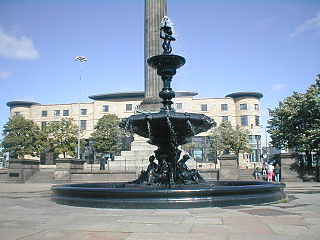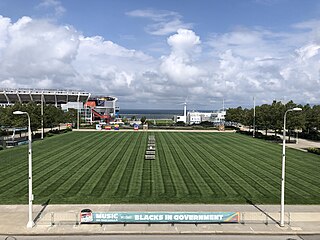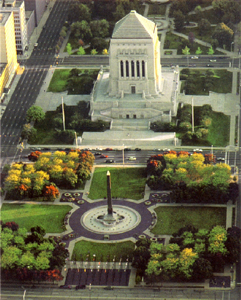
The Archibald Fountain, properly called the J. F. Archibald Memorial Fountain, is located in Hyde Park, in central Sydney. It is named after J. F. Archibald, owner and editor of The Bulletin magazine, who bequeathed funds to have it built. Archibald specified that it must be designed by a French artist, both because of his great love of French culture and to commemorate the association of Australia and France in World War I. He wished Sydney to aspire to Parisian civic design and ornamentation. The artist chosen was François-Léon Sicard, who completed it in Paris in 1926 but never saw the sculpture be placed in Sydney, where it was unveiled on 14 March 1932 by the Lord Mayor of Sydney, Samuel Walder.

Oakland is the academic and healthcare center of Pittsburgh and one of the city's major cultural centers. Home to three universities, museums, hospitals, shopping venues, restaurants, and recreational activities, this section of the city also includes two city-designated historic districts: the mostly residential Schenley Farms Historic District and the predominantly institutional Oakland Civic Center Historic District, as well as the locally-designated Oakland Square Historic District.

Schenley Park is a large municipal park in Pittsburgh, Pennsylvania, United States. It is located between the neighborhoods of Oakland, Greenfield, and Squirrel Hill. It is also listed on the National Register of Historic Places as a historic district. In 2011, the park was named one of "America's Coolest City Parks" by Travel + Leisure.

The Steble Fountain stands in William Brown Street, Liverpool, England, to the west of Wellington's Column. It is recorded in the National Heritage List for England as a designated Grade II* listed building. It was donated to the city by a former mayor to fill a vacant plot to the west of the column. For much of the 2010s and 2020s, the fountain has needed repair and has not functioned.

Victor David Brenner was a Lithuanian sculptor, engraver, and medalist known primarily as the designer of the United States Lincoln Cent.

The Cleveland Mall is a landscaped public park in downtown Cleveland, Ohio. One of the most complete examples of City Beautiful design in the United States, the park is a historic site listed on the National Register of Historic Places.

Fountain of Time, or simply Time, is a sculpture by Lorado Taft, measuring 126 feet 10 inches (38.66 m) in length, situated at the western edge of the Midway Plaisance within Washington Park in Chicago, Illinois, in the United States. The sculpture is inspired by Henry Austin Dobson's poem "Paradox of Time". Its 100 figures passing before Father Time were created as a monument to the 100 years of peace between the United States and the United Kingdom following the Treaty of Ghent in 1814. Father Time faces the 100 from across a water basin. The fountain's water was turned on in 1920, and the sculpture was dedicated in 1922. It is a contributing structure to the Washington Park United States Registered Historic District, which is a National Register of Historic Places listing.

Giuseppe Moretti was an Italian émigré sculptor who became known in the United States for his public monuments in bronze and marble. Notable among his works is Vulcan in Birmingham, Alabama, which is the largest cast iron statue in the world. On a personal level, Moretti was "known for his eclectic personality and for always wearing a green tie," but professionally, is claimed to be "the first man to use aluminum in art." Moretti enjoyed some celebrity in his lifetime, and was a friend of famed Italian tenor Enrico Caruso. It is even reported that the singer repeatedly praised Moretti's voice.
Pittsburgh Parks Conservancy was founded in December 1996 by a group of citizens concerned with the deteriorating conditions of Pittsburgh’s historic city parks. A non-profit organization, the Parks Conservancy works closely with the City of Pittsburgh under an official public-private partnership agreement to restore and improve the city’s park system to its full potential. To date, the Parks Conservancy has raised more than $130 million and completed 22 major park improvement projects. A team of 40 dedicated Parks Conservancy employees work with thousands of volunteers, host hundreds of events, and provide programming for more than 7,500 children annually.

Schenley Plaza is a public park serving as the grand entrance into Schenley Park in Pittsburgh, Pennsylvania.

Stephen Foster is a landmark public sculpture in bronze by Giuseppe Moretti formerly located on Schenley Plaza in the Oakland section of Pittsburgh, Pennsylvania. Formerly sited along Forbes Avenue near the entrance of Carnegie Museum of Natural History, in the shadow of Dippy, a life-size sculpture of a Diplodocus dinosaur, and in close proximity to the University of Pittsburgh's Stephen Foster Memorial, the Foster statue is one of the city's best known and most controversial. It was removed on April 26, 2018 on the unanimous vote of the Pittsburgh Art Commission.

The Henry Clay Frick Fine Arts Building is a landmark Renaissance villa and a contributing property to the Schenley Farms-Oakland Civic Historic District on the campus of the University of Pittsburgh in Pittsburgh, Pennsylvania, United States. The Frick Fine Arts Building sits on the southern edge of Schenley Plaza, opposite The Carnegie Institute, and is the home of Pitt's History of Art and Architecture Department, Studio Arts Department, and the Frick Fine Arts Library. Before its front steps is Mary Schenley Memorial Fountain.

A panther is the animal that serves as the official mascot of the University of Pittsburgh and used as a nickname for both athletic teams as well as other organizations and affiliates of the university. The mascot is generally referred to as the Pittsburgh Panther or Pitt Panther, while the costumed panther mascot is also named "Roc". Up to 20 physical representations of panthers can be found in and around the university's campus and athletic facilities.

The Indiana World War Memorial Plaza is an urban feature and war memorial located in downtown Indianapolis, Indiana, United States, originally built to honor the veterans of World War I. It was conceived in 1919 as a location for the national headquarters of the American Legion and a memorial to the state's and nation's veterans.

The Schenley Farms Historic District, also referred to as the Schenley Farms–Oakland Civic District, is a historic district listed on the National Register of Historic Places that is located in the Oakland section of Pittsburgh, Pennsylvania, United States.

Depew Memorial Fountain is a freestanding fountain completed in 1919 and located in University Park in downtown Indianapolis, Indiana, within the Indiana World War Memorial Plaza.

The Bartholdi Fountain is a monumental public fountain, designed by Frédéric Auguste Bartholdi, who later created the Statue of Liberty. The fountain was originally made for the 1876 Centennial Exposition in Philadelphia, Pennsylvania, and is now located at the corner of Independence Avenue and First Street, SW, in the United States Botanic Garden, on the grounds of the United States Capitol, in Washington D.C.

The Dupont Circle Fountain, formally known as the Rear Admiral Samuel Francis Dupont Memorial Fountain, is a fountain located in the center of Dupont Circle in Washington, D.C. It honors Rear Admiral Samuel Francis Du Pont, a prominent American naval officer and member of the Du Pont family. The fountain replaced a statue of Du Pont that was installed in 1884. Designed by Henry Bacon and sculpted by Daniel Chester French, the fountain was dedicated in 1921. Prominent guests at the dedication ceremony included First Lady Florence Harding, Secretary of War John W. Weeks and Secretary of the Navy Edwin Denby.

















